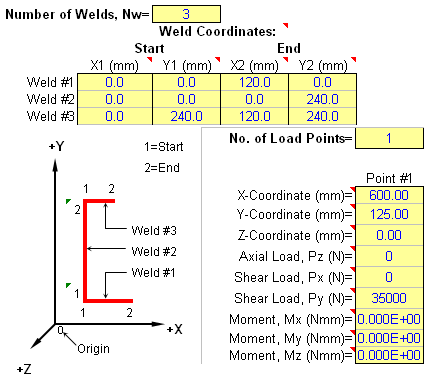WELDGRP Metric.xls

Description
This is a reworking of Alex Tomanovich's spreadsheet 'WELDGRP.XLS' It has reworked for metric units.
It includes an verification calculation to demonstrate that the table functions correctly.
'WELDGRP' is a spreadsheet program written in MS-Excel for the purpose of analysis of weld groups using the elastic method ('Alternate Method 1' in AISC Manual). A separate worksheet contains data tables for welds.
Calculation Reference
Machine Design Juvinall
Scahum's Machine Design
Analyzing weld groups using the elastic method, also known as 'Alternate Method 1' in the AISC Manual, involves considering the weld group as an equivalent member with an effective cross-sectional area. This method simplifies the analysis by assuming that the weld group behaves elastically and distributes the applied load evenly among the welds. Here's a step-by-step guide for performing this analysis:
- Identify the weld group configuration: Determine the type of weld group and its arrangement. Common weld group configurations include fillet welds, plug welds, or slot welds in various arrangements.
- Calculate the effective throat thickness: Determine the effective throat thickness (t_eff) for the weld group. It is typically defined as the minimum throat thickness among the welds in the group.
- Determine the effective length: Calculate the effective length (L_eff) of the weld group based on its configuration and boundary conditions. The effective length is used to determine the effective length factor (K_eff), which accounts for the behavior of the weld group in transmitting the applied load.
- Calculate the effective area: Determine the effective cross-sectional area (A_eff) of the weld group by multiplying the effective throat thickness (t_eff) by the effective length factor (K_eff).
- Determine the effective yield strength: Determine the effective yield strength (F_eff) of the weld group based on the material properties of the base metal and the weld metal. This can be obtained from the appropriate design code or reference material.
- Calculate the design strength: Calculate the design strength (φR_n) of the weld group by multiplying the effective cross-sectional area (A_eff) by the effective yield strength (F_eff), and applying the appropriate resistance factor (φ). The resistance factor depends on the type of weld and the loading conditions.
- Compare design strength and applied loads: Compare the design strength (φR_n) of the weld group to the applied loads. Ensure that the design strength is greater than or equal to the applied loads to ensure structural safety.
It's important to note that the elastic method provides simplified analysis and may not account for all possible failure modes or load distributions in complex weld group configurations.
Calculation Preview
Full download access to any calculation is available to users with a paid or awarded subscription (XLC Pro).
Subscriptions are free to contributors to the site, alternatively they can be purchased.
Click here for information on subscriptions.

